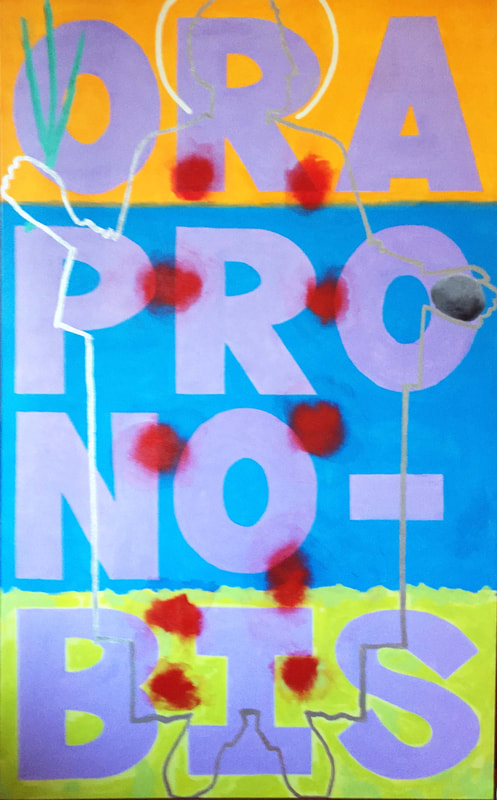They are us. The sacred texts hold a mirror up to the hearer not only urging us summon the courage the be faithful servants, but also challenging us to recognize the villain within ourselves. These stories call us not only to be watchful and alert, but also to be proactive in the divine plan. Today, we conclude with postscript of sorts in the story of Stephen, the Ready Martyr.
“Beware of men, for they will hand you over to courts
and scourge you in their synagogues,
and you will be lead before governors and kings for my sake.
Brother will hand brother to death, and the father his child.
Children will revolt against parents and have them put to death.
You will be hated by all because of my name."
the Good News according to Matthew
(from the Ora Pro Nobis series)
oil on canvas
Daniel Kennedy
2000
Sorry to kill the holiday cheer! But it is not just me; the liturgical year does not even give us a chance to catch our breath from the festivities before we get the gruesome story of the stoning of Stephen. This back-to-back sequence of birth and homicide is not chronology, but rather intentional theology. In retrospect we should not be surprised. The whole of the Advent season has pointed repeatedly to the high cost of discipleship.
Daniel Kennedy’s Saint Stephen comes from a series of images of holy people that lined the walls of a theological school library. In this rendering, Stephen is only glimpsed in a silver outline as if he is merely memory. In one hand he holds a stone and in the other a laurel branch … his death and his victory. He is clothed in a dalmatic, the symbol of his ministry of service, and a halo surrounds his head. But the outline of the martyr recedes in this rendering. The dominant element of Kennedy’s composition is not the person, but rather the blood-red wounds and the liturgical refrain “ora pro nobis”. The artist captures the theological reason for the startling sequence of these days in these two elements.
“Ora pro nobis” (pray for us) is the congregational response within the ritual calling of the saints on significant holy days throughout the year. This liturgical prayer is a form of memory/anamnesis or making present the gifts and graces of a past events. The congregation’s response to the invocation of each named saint has a two-fold purpose; to both ask for intercession and to celebrate their willing participation in the divine plan for all God’s creation. The cadence of this call and response is a communal chant that literally folds time and space to bring saints of the past together with the saints of the present. In this ritual action all God’s people find their strength and their purpose in a time-defying and multi-era communal event.
Stephen, like a whole group of early witnesses to the gospel, when confronted with the alternative of renouncing their faith or suffering death, many voluntarily embraced the death prepared for them. While this action might seem to some to run perilously close to recklessness (or even suicide), the passions that motivate these actions are at the very core of the commemorations we celebrate in the shadow of the nativity. Stephen was not simply protecting some private claim to win his salvation, he was convinced that the good news of the gospel could radically change the way the world could see itself. He knew the transformative possibilities of love and therefore renouncing his faith in that promise was unimaginable. Out of his great love, God had intervened in human history and Stephen was an inheritor of that vision … and that vision was worth dying for. The self-sacrifice and the blood-red wounds were not personal triumph, Stephen saw himself as a warrior in this great reawakening. Stephen’s self-sacrifice in the cause of love, justice and social transformation is not death … it is life eternal. Now that is a nativity!
In Toni Morrison's Beloved, Baby Suggs begins her sermon in the clearing with an invocation. She calls the people to gather with laughter, dancing, and crying in an urgent celebration of bodiliness, a manifestation of incarnate grace.
"Saying no more, she stood up then and danced with her twisted hip the rest of what her heart had to say while the others opened their mouths and gave her the music. Long notes held until the four-part harmony was perfect enough for their deeply loved flesh."
Jesus told his disciples that God's reign is among them, in the midst of them, within them. The learning, building, and mending begins here and now.
A stronghold to give me safety.
You are my rock and fortress.
For your name’s sake you will lead and guide me.
Into your hand I commend my spirit.
the unnamed lyricist of the 31st psalm
Suggestions for further exploration:
- Read and meditate on the daily readings for the Feast of St. Stephen.
- Explore the writings of Martin Luther King, Jr. Perhaps begin with Letter from a Birmingham Jail or Strength to Love.
- Work your way through My Grandmother’s Hands. In this book, Resmaa Menakim explores how racialized trauma manifests in our physical bodies and offers practices and exercises to begin healing and recovery.
- Spend time with the poems of Mary Oliver. Much of her work reflects on embodiment, grace, and awareness of the present moment. Perhaps begin with Mornings at Blackwater, Mindful or The Journey.













 RSS Feed
RSS Feed